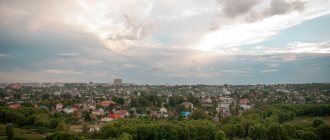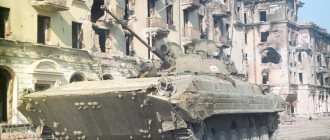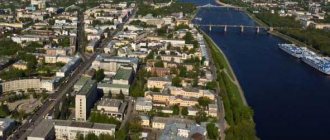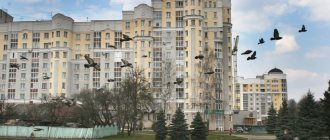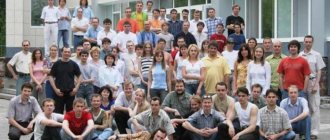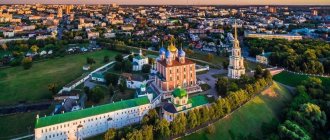History of Taganrog[edit]
Main article: History of Taganrog
The history of the city dates back to the late Bronze Age - early Iron Age (between the 20th and 10th centuries BC), when it was the earliest Greek settlement in the north-west Black Sea region and was mentioned by the Greek historian Herodotus as Emporion Kremnoi. [17] In the 13th century, Pisan merchants founded the colony Portus Pisanus, which, however, did not last long. [18] Taganrog was founded by Peter the Great on September 12, 1698. [3] The first Russian Navy base, it hosted the Azov flotilla of Catherine the Great (1770–1783), which later became the Russian Black Sea Fleet. Taganrog received city status in 1775. [4]
By the end of the 18th century, Taganrog lost its importance as a military base after Crimea and the entire Sea of Azov were annexed to the Russian Empire. In 1802, Emperor Alexander I granted the city special status, which lasted until 1887. In 1825, Alexander I's palace in Taganrog was used as his summer residence, and he died there in November 1825. Also in Taganrog is the House of the Teacher, a mansion, in which featured numerous artists. Although it was shelled and damaged by the Anglo-French fleet in 1855, [18] Taganrog became an important trading port, used for the import and export of grain, from the late 19th century to the early 20th century. Industrialization increased in the city when Belgian and German investors founded a boiler factory, an iron and steel foundry, a leather factory, and an oil press factory. By 1911, fifteen foreign consulates had opened in the city. [19]
During World War I, Taganrog was occupied by German troops from May to August 1918. In 1919, General Anton Denikin established his headquarters in the city's Avgerino mansion, commanding the White Russian troops fighting in southern Russia during the Russian Civil War. War . When the White Russians were defeated on 25 December 1919 and Bolshevik rule was established in the city, Denikin's remaining troops and the British consulate were evacuated by HMS Montrose. Full powers were granted to the executive committee of the city council of the workers' council on December 17, 1920, and Taganrog briefly became part of the Ukrainian SSR as the administrative center of the Taganrog Okrug until it was transferred to the Russian SFSR along with the Shakhty Okrug on October 1, 1924. During World War II, Taganrog was occupied by Nazi Germany from 1941 to 1943 during Operation Barbarossa, when two SS divisions entered the city on October 17, 1941, followed by Wehrmacht divisions, with the city heavily damaged. The occupation led to the replacement of the local government system with the Bürgermeisteramt
(city hall) in the German style, which governed the city until it was liberated by the authorities. Red Army on August 30, 1943.
Taganrog city
Symbolism
| Flag | Coat of arms |
Anthem of Taganrog
Administration
347900, Taganrog, st. Petrovskaya, 73
Phone +7 (8634) 312-800, fax +7 (8634) 312-730
Housing and communal services hotline
Official site
www.tagancity.ru
Head of the Taganrog city administration
Solonitsin Mikhail Vladimirovich
Geography
Taganrog is the second largest city in the Rostov region, located on the northern coast of the Taganrog Bay of the Sea of Azov.
The distance from the mouth of the Don River, on the one hand, and from the border with Ukraine, on the other hand, is about 50 km, the distance from Moscow is 950 km, from Rostov-on-Don - 60 km. The area of the city is 85 square meters. km, population – more than 248.7 thousand people.
Story
Taganrog was founded in 1698 by Peter I and became Russia's first naval base. The further development of the city was closely connected with the names of Catherine II, Alexander I and other famous statesmen who had a noticeable influence on its formation and development.
After the annexation of Crimea to Russia, Taganrog from a fortified city became a rich port city, which played a leading role in Russian trade in the southern direction.
Since the end of the 19th century, a number of large industrial enterprises have been created in the city, including those with the participation of foreign capital. Then, in the 20-30s of the 20th century, the industrial base of the city was significantly expanded.
During the Great Patriotic War, Taganrog was occupied for almost two years. The largest underground organization in the south of the country operated in the city; G. Hoffmann’s book “Heroes of Taganrog” is dedicated to the fight against the fascists. With the liberation of Taganrog on August 30, 1943, the complete liberation of the Rostov region from the Nazi invaders was completed.
Taganrog - City of military glory. This honorary title was awarded to Taganrog for the courage, resilience and mass heroism shown by the city’s defenders in the struggle for freedom and independence of the Fatherland by Decree of the President of the Russian Federation of November 3, 2011 No. 1459.
After the war, the restoration of the urban economy proceeded at a rapid pace. In the 60-90s, in addition to industry, the social, cultural spheres, and the communication network received significant development.
Economy
Taganrog is a large industrial, scientific, cultural and historical center, one of the leading seaports on the southern borders of Russia.
On its territory there are: 2 passenger and 2 freight railway stations, a sea trade port, 2 runways, 2 bus stations for suburban and intercity traffic.
There are more than 4,100 small enterprises, organizations of all forms of ownership, 268 large and medium-sized enterprises, organizations and branches, and about 8,300 individual entrepreneurs operating in the city.
The city-forming and system-forming enterprises are: PJSC Taganrog Metallurgical Plant, PJSC Taganrog Boiler-Making Plant, PJSC Taganrog Aviation Scientific and Technical Complex named after. G.M. Beriev", JSC "Red Hydropress", JSC "Taganrogsky", JSC "TNIIS", LLC "Khlebzernoprodukt", LLC "Karavai Yug", JSC "Famadar Kartona Limited", JSC "PromTyazhMash" and others.
The city has a fairly well-developed tourism infrastructure, which includes: 42 hotels and other accommodation facilities in the mid-price segment with 955 rooms and 1,907 places for one-time accommodation.
Culture
Taganrog is known in Russia and far beyond its borders as the birthplace of many outstanding people. The artist K. Savitsky and the architect J. Rubanchik were born here; actress F. Ranevskaya and the “pioneer” of Soviet jazz V. Parnakh; designer L. Gobyato and poetess S. Parnok; writer I. Vasilenko and poet M. Tanich; historian A. Lakier and director I. Perestiani.
The names of the revolutionary P.P. are also associated with the city. Schmidt, artist A.K. Kuindzhi, writer K.G. Paustovsky, trainer A.A. Durov, singer E.V. Obraztsova, aircraft designers G.M. Berieva, R.L. Bartini and V.M. Petlyakov, writer and public figure N.V. Kukolnik, surgeon N.A. Bogoraz and many others.
Taganrog is the birthplace of the great Russian writer Anton Pavlovich Chekhov. The presence of Chekhov is still felt in the city, where everything connected with the memory of the brilliant countryman is carefully preserved - the house where the writer was born, the shop of his father, who traded in colonial goods, the gymnasium, where the exposition of the literary museum is now located, the theater that now houses it name, the public library he helped create.
The network of municipal cultural institutions consists of 19 institutions whose activities are aimed at providing additional education for children, cultural and leisure activities, and library services to the population.
A charity event “Under the Flag of Good!” is held annually in Taganrog. The main goal of this campaign is targeted assistance to children in need of expensive treatment.
Taganrog is rightly called an open-air museum city; Many ancient mansions, architectural and historical monuments have been preserved here, including the Stone Staircase, the Palace of Alexander I, the building of the city theater, the Alferaki Palace, St. Nicholas and All Saints churches, monuments to Peter I and A.P. Chekhov.
Attractions
Sights of the city of Taganrog
Climate[edit]
The climate of Taganrog is temperate (according to the Köppen climate classification Cfb
). Taganrog has moderately cold (by Russian standards, mild) winters and hot summers.
| Climate data for Taganrog | |||||||||||||
| Month | Jan | Feb | Mar | Apr | May | Jun | Jul | Aug | Sep | October | But I | December | Year |
| Average high °C (°F) | 0,1 (32,2) | 0,3 (32,5) | 5,9 (42,6) | 15,4 (59,7) | 22,1 (71,8) | 25,8 (78,4) | 28,8 (83,8) | 27,8 (82,0) | 21,8 (71,2) | 14,6 (58,3) | 5,5 (41,9) | 0,6 (33,1) | 14,1 (57,3) |
| Daily average °C (°F) | -2,6 (27,3) | -2,2 (28,0) | 2,7 (36,9) | 11,1 (52,0) | 17,6 (63,7) | 21,4 (70,5) | 24,6 (76,3) | 23,8 (74,8) | 18,1 (64,6) | 11,1 (52,0) | 2,8 (37,0) | −2,1 (28,2) | 10,5 (50,9) |
| Average low °C (°F) | -5,5 (22,1) | -5,8 (21,6) | -0,7 (30,7) | 6,3 (43,3) | 12,4 (54,3) | 16,5 (61,7) | 19,7 (67,5) | 19,0 (66,2) | 13,8 (56,8) | 7,4 (45,3) | 0,3 (32,5) | -4,8 (23,4) | 6,6 (43,8) |
| Average precipitation, mm (inches) | 43 (1,7) | 40 (1,6) | 34 (1,3) | 38 (1,5) | 38 (1,5) | 58 (2.3) | 61 (2,4) | 39 (1,5) | 33 (1,3) | 34 (1,3) | 42 (1,7) | 50 (2,0) | 510 (20,1) |
| Source: Rostov-meteo.ru [20] | |||||||||||||
Economics [edit]
Taganrog is the leading industrial center of the Rostov region. Local industry is represented by aerospace, engineering, automotive, military, iron and steel, mechanical engineering, metal traders and processors, timber, woodworking, pulp and paper, food, light, chemical and construction industries, as well as one of the main ports of the Azov Sea .
The largest company currently operating in Taganrog is the Taganrog Metallurgical Plant (public), which produces steel, steel pipes for the oil and gas industry, and consumer goods. Another large employer is Taganrog Auto), created on the basis of the Taganrog Combine Harvester Plant. The plant produces cars under Hyundai license. The product line includes the compact Hyundai Accent sedan, mid-size Hyundai Sonata, Santa Fe SUV and Hyundai Porter pickup truck.
Taganrog is also home to the Beriev aircraft design bureau.
The area around Taganrog has great industrial potential, diversified agriculture, manufacturing enterprises and modern infrastructure. Taganrog's location at the intersection of transport routes and a seaport facilitates access to developing CIS markets.
Taganrog's main trading partners are the CIS countries, South Korea, Turkey, Italy, Greece and Egypt.
The first personnel center in the Don, “Work of Russia”, opened in Taganrog
Rostov region, January 13, 2022. DON24.RU. The first personnel training center in the Rostov region opened in Taganrog, reports the press service of the Don government.
Large-scale modernization of the employment service in the region is taking place within the framework of the federal project “Promotion of Employment” of the national program “Demography”.
“The personnel center that we are opening today features new services, easy navigation, functional areas for working with visitors, digital services, personal consultants, and convenient access to a vacancy bank. This is a new type of personnel center, where job seekers and employers can receive a range of services in the field of employment using modern approaches and technologies. And it is very important that the implementation of this project began in Taganrog, since the issue of comprehensive development of Taganrog is under the special control of the head of the region Vasily Golubev,” noted Deputy Governor of the region Artem Khokhlov, who was present at the opening.
Modernization has affected the external image that has developed in the minds of clients of the employment service, and the staff: employees are being retrained, and their main task is now to become career and personnel consultants.
At the same time, the employment service as a modern personnel center is reoriented from providing individual services to solving a whole range of issues in accordance with the life situation of clients or the business situation of employers. It is planned to gradually transfer government services to a digital format, which will help save time for visitors to employment centers. The result of such transformations will be an improvement in the quality of life of citizens and the economic performance of enterprises and organizations, both Taganrog and regional.
The work of the new personnel center will be built on the “one-window” principle, where the main online resource for job search and selection of employees will be a single digital platform in the field of employment and labor relations “Work in Russia”.
“We expect that about 14 thousand citizens and more than 1000 employers will be able to use the services of the new center annually,” said Irina Shapkina, director of the Taganrog Employment Center.
The “Employment Promotion” project of the national program “Demography” provides for the implementation of measures to modernize one employment center annually until 2024. It is planned to create three more similar centers on the Don.
Taganrog in literature [edit]
Assumption Cathedral in Taganrog, Russia (1818–1938), where Anton Chekhov was baptized on February 10, 1860.
The image of the city and its people in numerous works by A.P. Chekhov, including Ionych
,
House with a Mezzanine
,
Man in a Case
,
Vanka
,
three years old
,
mask
, and
My Life
.
It is believed that the image of Taganrog can be used as Lukomorye
(fairy-tale land) in Alexander Pushkin's work
Ruslan and Lyudmila
(1820).
[ citation needed
] It also appeared in the novels of Ivan Vasilenko and Konstantin Paustovsky and in the poems of Nikolai Shcherbina and Valentin Parnakh.
The conspiratorial legend of the "elder Fyodor Kuzmich" is quoted in the book of the Russian mystic Daniil Andreev, Rose of the World
".
According to this legend, Russian Tsar Alexander I did not die in Taganrog, but instead abandoned his crown and status as monarch to continue the life of a wandering hermit. [ citation needed
]
In foreign literature, the city was mentioned in the title of Der Tote von Taganrog
by Eberhard von Cranach-Sichart and
Taganrog
by Reinhold Schneider.
In 2004, Sabina Wichert published a collection of poems " Taganrog"
.
In Maria Kuntsevichova's 1945 novel The Stranger (New York, LB Fischer), the city of Taganrog plays an important role as a place of nostalgic happiness for the exiled Polish musician and matriarch Rosa.
The “reset” of Taganrog began with the visit of the Speaker of the Federation Council
The starting point for creating the “road map” can be considered the visit of Federation Council Chairman Valentin Matvienko to the Rostov region in September last year. Then she visited the Sambek Heights memorial complex, as well as Taganrog itself, noting the high tourism potential of the city and region. The speaker promised that she would provide budget support to develop tourism there.
“Taganrog is Peter’s city, and she was the governor of St. Petersburg...”, Don Governor Vasily Golubev explained the motives of the federal official on the air of the regional TV channel Don24.
At the same time, according to Deputy Governor Alexander Scriabin, with the support of the head of the region, the city administration took the initiative to develop a set of measures for the development of Taganrog as a tourist center. In terms of tourism development, a comprehensive balneological study of the territory, classification of the beaches of the sea coast, and installation of tourist navigation signs were planned. The project also included the holding of events that have become the hallmark of the city: the “Defense of Taganrog 1855” and “Umbrella Morning” festivals, the Chekhov regatta “The Seagull”, the Chekhov Theater Festival. The creation of an exposition of the local history museum (Alferaki Palace) and activities to promote the city within the framework of the tourist brand of the “Free Don” region were also noted.
However, this was a list of far from the most financially intensive events. Much more large-scale work includes the reconstruction of roads, improvement of popular city locations, and development of a hotel complex. The organization of regular passenger transport by water transport between tourist centers not only in the region, but also in the south of Russia was also considered. All this should attract more tourists to the city. However, specific targets were never presented.
The only attempt to attract the public to such a large-scale project was that until February 14, a call for proposals from Taganrozh residents was announced. More than 300 messages were sent to the city administration's email address. Then all of them were analyzed and structured by the administration staff. As a result, until 2023, they planned activities “with a confirmed budget” to organize festivals, modernize the track and power grid, update the rolling stock of city electric transport, repair and restoration of facades and roofs of historical buildings, and modernize the water supply and sewerage system. In the longer term, it is planned to modernize the lines of outdoor lighting networks, reclaim the solid waste landfill, develop a set of rules and recommendations for the formation of a unified design code, as well as improvement and reconstruction of streets and beaches, water supply systems, and bank protection works.
In March, information appeared on the regional administration’s website about the creation of a working group for the integrated development of the city as a tourist center. It consists of 32 people, the vast majority of whom are regional and municipal officials. Only five from this list are representatives of public organizations and businesses. The group was led by Alexander Scriabin.
Famous people[edit]
Faina Ranevskaya's birth house
Main article: List of residents of Taganrog
Many Russian and foreign aristocrats, politicians, artists and scientists were born and/or lived in Taganrog. Taganrog is the hometown of Anton Chekhov, Faina Ranevskaya, Sofia Parnok, Alexander Koyre, Isaac Yakovlevich Pavlovsky, Dmitry Sinodi-Popov; the names of Russian emperors Peter I of Russia and Alexander I of Russia; Cornelius Kroyce, Giuseppe Garibaldi, Pyotr Tchaikovsky, Adolf Brodsky, Konstantin Paustovsky, Nestor Kukolnik, When Taganrog is mentioned, Achilles Alferaki, Ioannis Varvakis, Sergei Bondarchuk, William Frederick Yeames and many other famous people come to mind. [ citation needed
]
- Monument to Alexander I in Taganrog
- Monument to Garibaldi in Taganrog
- Monument to Chekhov in Taganrog
- Monument "Artemka"
Links[edit]
Notes[edit]
- ^ abcde Law No. 340-ZS
- Decision No. 537
- ^ abc Charter of Taganrog, article 2
- ^ ab Encyclopedia of Russian Cities
. Moscow: Great Russian Encyclopedia. 2003. pp. 454–455. ISBN 5-7107-7399-9. - ^ a b Charter of Taganrog, article 12
- Official website of Taganrog. Andrey Vladimirovich Lisitsky, head of the Taganrog City Administration (in Russian)
- Official website of Taganrog. Information about Taganrog (in Russian)
- ^ abc Federal State Statistics Service (2011). “All-Russian Population Census 2010. Volume 1" [All-Russian Population Census 2010, vol. 1]. All-Russian Population Census 2010 [All-Russian Population Census 2010]
. Federal State Statistics Service. - "26. The size of the permanent population of the Russian Federation by municipalities as of January 1, 2022". Federal State Statistics Service. Retrieved January 23, 2022.
- ^ abc Law No. 190-ZS
- "On the Calculation of Time". Official Internet portal of legal information
. June 3, 2011. Retrieved January 19, 2022. - Post office. Information and computing center of OASU RPO. ( Post office
).
Search for postal service objects ( postal Search for objects
) (in Russian) - ↑
Federal State Statistics Service of Russia (May 21, 2004).
“The population of Russia, the constituent entities of the Russian Federation as part of federal districts, urban settlements, settlements, settlements is 3 thousand or more people” [Population of Russia, its federal districts, federal districts, districts Urban settlements, rural settlements - administrative centers and rural settlements with a population of over 3,000] (XLS). All-Russian Population Census 2002
. - “All-Union Population Census of 1989. The current population of union and autonomous republics, autonomous regions and districts, territories, negative phenomena, urban settlements and villages. All-Union Population Census of 1979. National composition of the population by regions of Russia” [All-Union Population Census of 1979. Ethnic composition of the population by regions of Russia] (XLS). All-Union Population Census of 1979 [All-Union Population Census of 1979]
.
1979 - via Demoscope Weekly
(website of the Institute of Demography of the State University - Higher School of Economics. - Federal State Statistics Service of Russia (Internet).
- "taganrogcity.com - Ancient history of Taganrog". taganrogcity.com
. - ^ ab Chisholm, Hugh, ed. (1911). "Taganrog". Encyclopedia Britannica
.
26
(11th ed.). Cambridge University Press. pp. 355–356. - "taganrogcity.com - History of Taganrog in the 19th century". taganrogcity.com
. - "Rostov-meteo.ru". Retrieved April 17, 2012.[ permanent dead link
] - "Cities are partners". tagancity.ru
(in Russian). Taganrog. Retrieved February 5, 2022.
Sources [edit]
- Taganrog City Duma. Decision No. 537 of October 25, 2007 “On the official symbols of the municipal formation” City of Taganrog “,” as amended. Decision No. 73 of March 31, 2015 “On amendments to some Decisions of the City Duma of the city of Taganrog.” Came into force on the date of official publication. Published: “Official Taganrog”, No. 35, November 10, 2007 (Taganrog City Duma. Decision No. 537 of October 25, 2007 “ On the official symbols of the municipal entity “Taganrog City”
as amended by decision No. 73 of March 31, 2015. “
On amendments to various decisions of the City Duma”).
city of Taganrog ( comes into force on the date of official publication). - City Duma of the city of Taganrog. Decision No. 318 of June 3, 2011 “On the adoption of the Charter of the municipal formation” City of Taganrog “,” as amended. Decision No. 243 of September 29, 2016 “On introducing amendments and additions to the Charter of the municipal formation” City of Taganrog “”. Came into force on the date of official publication after registration. Published: “Official Bulletin of Taganrog”, No. 16, July 25, 2011 (City Duma of the city of Taganrog. Decision No. 318 of June 3, 2011 “ On
the adoption
of the Charter of the municipal formation “Taganrog City”
as amended by Resolution No. 243 of September 29, 2016 "
On introducing amendments and additions to the Charter of the municipal formation "City of Taganrog". Charter of the municipal formation "City of Taganrog"
. Valid from the date of official publication after registration.). - Legislative Assembly of the Rostov region. Law No. 340-ZS of July 25, 2005 “On the administrative-territorial structure of the Rostov region,” as amended. Law No. 270-ZS of November 27, 2014 “On Amendments to the Regional Law” On the Administrative-Territorial Structure of the Rostov Region “”. Came into force on the date of official publication. Published: “Our Time”, No. 187–190, July 28, 2005 (Legislative Assembly of the Rostov Region. Law No. 340-ZS of July 28, 2005 “ On the administrative-territorial structure of the Rostov Region”
as amended by Law No. 270 -ZS dated November 27, 2014 “
On Amendments to the Regional Law “On Administrative Management”).
-Territorial structure of the Rostov region" . Comes into force on the date of official publication.). - Legislative Assembly of the Rostov region. Law No. 190-ZS of November 19, 2004 “On establishing the border and granting the status of an urban district to the municipal formation” City of Taganrog “,” as amended. Law No. 980-ZS of October 25, 2012 “On amendments to regional laws” On establishing boundaries and granting the status of an urban district to the municipal formation “Taganrog City” and “On establishing and granting the corresponding status to the municipal formation” Neklinovsky district “and municipalities in its composition." January 2005 Published: “Our Time”, No. 293–295 (without attachments), November 30, 2004 (Legislative Assembly of the Rostov Region. Law No. 190-ZS of November 19, 2004) On establishing the border and giving the status of a city district to the municipal formation "City of Taganrog"
as amended by Law No. 980-ZS of October 25, 2012 "
On amendments to the laws of the region "On establishing boundaries and assigning the status of an urban district" to the municipal formation "City of Taganrog" and "On establishing boundaries and assigning corresponding status to the municipal formation “Neklinovsky district” and its constituent municipalities
. Effective January 1, 2005).

